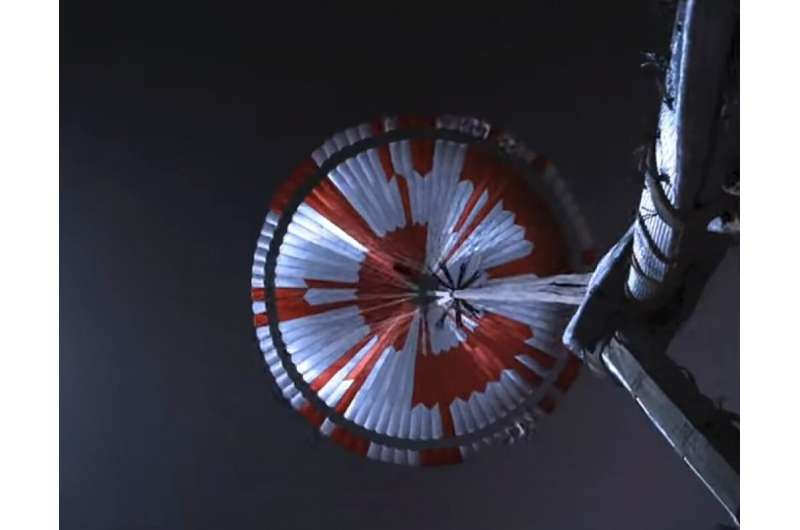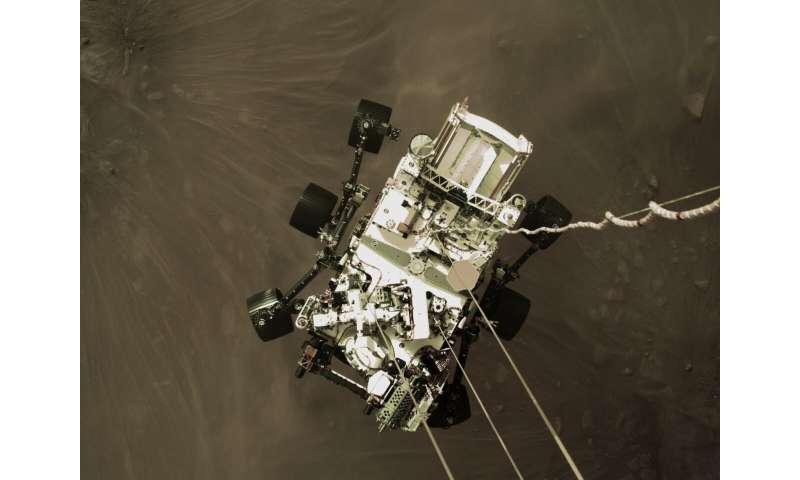
The US space agency NASA on Monday released the first audio from Mars, a faint crackling recording of a gust of wind captured by the Perseverance rover.
NASA also released the first video of last week's landing of the rover, which is on a mission to search for signs of past life on the Red Planet.
A microphone did not work during the rover's descent to the surface, but it was able to capture audio once it landed on Mars.
NASA engineers played a 60-second recording.
"What you hear there 10 seconds in is an actual wind gust on the surface of Mars picked up by the microphone and sent back to us here on Earth," said Dave Gruel, lead engineer for the camera and microphone system on Perseverance.
The high-definition video clip, lasting three minutes and 25 seconds, shows the deployment of a red-and-white parachute with a 70.5-foot-wide (21.5-meter-wide) canopy.
It shows the heat shield dropping away after protecting Perseverance during its entry into the Martian atmosphere and the rover's touchdown in a cloud of dust in the Jezero Crater just north of the Red Planet's equator.
"This is the first time we've ever been able to capture an event like the landing on Mars," said Michael Watkins, director of NASA's Jet Propulsion Laboratory, which is managing the mission.
"These are really amazing videos," Watkins said. "We binge-watched them all weekend."
Thomas Zurbuchen, NASA's associate administrator for science, said the video of Perseverance's descent is "the closest you can get to landing on Mars without putting on a pressure suit."
'Perseverance is healthy'
Jessica Samuels, Perseverance's surface mission manager, said the rover was operating as expected so far and engineers were conducting an intensive check of its systems and instruments.
"I am happy to report that Perseverance is healthy and is continuing with activities as we have been planning them," Samuels said.
She said the team was preparing for a flight by the rover's small helicopter drone dubbed Ingenuity.
"The team is still evaluating," she said. "We have not locked in a site yet."
Ingenuity will attempt the first powered flight on another planet and will have to achieve lift in an atmosphere that is just one percent the density of Earth's.
Perseverance was launched on July 30, 2020 and landed on the surface of Mars on Thursday.
Its prime mission will last just over two years but it is likely to remain operational well beyond that. Its predecessor Curiosity is still functioning eight years after landing on Mars.
Over the coming years, Perseverance will attempt to collect 30 rock and soil samples in sealed tubes to be sent back to Earth sometime in the 2030s for lab analysis.
About the size of an SUV, the craft weighs a ton, is equipped with a seven-foot-long robotic arm, has 19 cameras, two microphones and a suite of cutting-edge instruments.
Mars was warmer and wetter in its distant past, and while previous exploration has determined the planet was habitable, Perseverance is tasked with determining whether it was actually inhabited.
-

This high-resolution still image is part of a video taken by several cameras as NASA’s Perseverance rover touched down on Mars on Feb. 18, 2021. A camera aboard the descent stage captured this shot. A key objective for Perseverance’s mission on Mars is astrobiology, including the search for signs of ancient microbial life. The rover will characterize the planet’s geology and past climate, pave the way for human exploration of the Red Planet, and be the first mission to collect and cache Martian rock and regolith (broken rock and dust). Subsequent NASA missions, in cooperation with ESA (the European Space Agency), would send spacecraft to Mars to collect these cached samples from the surface and return them to Earth for in-depth analysis. The Mars 2020 mission is part of a larger program that includes missions to the Moon as a way to prepare for human exploration of the Red Planet. JPL, which is managed for NASA by Caltech in Pasadena, California, built and manages operations of the Perseverance and Curiosity rovers. Credits: NASA/JPL-Caltech -

This NASA handout photo shows an image from NASA's Perseverance rover after it landed on the surface of Mars -

This NASA video frame grab photo released on February 22, 2021 shows the surface of Mars, captured by the Perseverance rover -

This NASA photo released on February 22, 2021 shows the Navigation Cameras aboard NASA's Perseverance Mars rover
It will begin drilling its first samples in summer, and along the way it will deploy new instruments to scan for organic matter, map chemical composition and zap rocks with a laser to study the vapor.
One experiment involves an instrument that can convert oxygen from Mars' primarily carbon dioxide atmosphere, much like a plant.
The idea is that humans eventually won't need to carry their own oxygen on hypothetical future trips, which is crucial for rocket fuel as well as for breathing.
The rover is only the fifth to set its wheels down on Mars. The feat was first accomplished in 1997, and all of them have been American.
The United States is preparing for an eventual human mission to the planet, though planning remains very preliminary.
© 2021 AFP
Citation: NASA releases first audio from Mars, video of landing (Update) (2021, February 22) retrieved 23 February 2021 from https://ift.tt/3qNO6dN
This document is subject to copyright. Apart from any fair dealing for the purpose of private study or research, no part may be reproduced without the written permission. The content is provided for information purposes only.
"first" - Google News
February 23, 2021 at 04:33PM
https://ift.tt/3qNO6dN
NASA releases first audio from Mars, video of landing (Update) - Phys.org
"first" - Google News
https://ift.tt/2QqCv4E
https://ift.tt/3bWWEYd
Bagikan Berita Ini














0 Response to "NASA releases first audio from Mars, video of landing (Update) - Phys.org"
Post a Comment